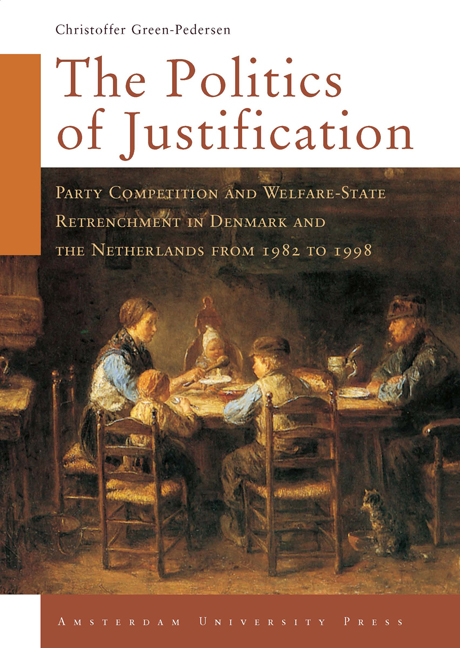 The Politics of Justification
The Politics of Justification Book contents
- Frontmatter
- Acknowledgments
- Contents
- List of Abbreviations
- 1 Introduction
- 2 From Theories of Expansion to Theories of Retrenchment
- 3 Framework for Government Choice on Retrenchment
- 4 Research Strategy and Research Design
- 5 Retrenchments in Denmark and the Netherlands
- 6 Dutch Politics and Welfare-State Retrenchment.How Party Competition Produced Consensus
- 7 Danish Politics and Welfare-State Retrenchment:The Difficulties of a Right-Wing Government and the Possibilities of a Left-Wing Government
- 8 The Evidence on Balance and some Quibbles
- 9 Party Politics Matter – Summary and Implications
- Appendix
- Summary
- Notes
- References
- Index
6 - Dutch Politics and Welfare-State Retrenchment.How Party Competition Produced Consensus
Published online by Cambridge University Press: 15 January 2021
- Frontmatter
- Acknowledgments
- Contents
- List of Abbreviations
- 1 Introduction
- 2 From Theories of Expansion to Theories of Retrenchment
- 3 Framework for Government Choice on Retrenchment
- 4 Research Strategy and Research Design
- 5 Retrenchments in Denmark and the Netherlands
- 6 Dutch Politics and Welfare-State Retrenchment.How Party Competition Produced Consensus
- 7 Danish Politics and Welfare-State Retrenchment:The Difficulties of a Right-Wing Government and the Possibilities of a Left-Wing Government
- 8 The Evidence on Balance and some Quibbles
- 9 Party Politics Matter – Summary and Implications
- Appendix
- Summary
- Notes
- References
- Index
Summary
The aim of this chapter is to take a closer look at Dutch politics and welfarestate retrenchment from 1982 to 1998. Yet, to make sense of what has happened from 1982, it is necessary to start out with a short section on Dutch politics and welfare-state retrenchment in the preceding period, 1973 to 1982. Subsequently, there will be sections describing each of the three types of governments that ruled the Netherlands in this period; the CDA-VVD governments from 1982 to 1989, the CDA-PVDA government from 1989 to 1994, and the PVDA-VVD-d66 governments from 1994.
More specifically, the aim is to establish how party strategies around retrenchment developed in the period in relation to other political parties and in relation to the electorate. For each period, there will be an investigation into the government initiatives concerning the welfare state, the societal reactions, how the governments have tried to legitimise their policies, and the reaction of the opposition. The focus will be on social security. Nevertheless, developments in other policy areas will be included to the extent that they are necessary to make sense of what happened in relation to social security. These issues have been studied using both primary and secondary sources.
Depillarisation and fumbling response to the oil crises
From a historical perspective, Dutch politics are one of the clearest examples of the politics of accommodation inherent in Lijphart's (1969) concept of ‘consociational democracy’. Due to a consensus at the elite level about power sharing, autonomy for the sub-cultures and proportionality, the conflicts stemming from the ‘pillarisation’ of Dutch society never materialised into an adversarial style of politics that could have threatened democratic stability (Lijphart 1979; Gladdish 1991: 33-49; Andeweg & Irwin 1993: 23-49). The consensual style of politics was also clearly visible in relation to party competition. In the two decades following the Second World War, the Netherlands was mainly governed by oversized coalitions. Members of these governments belonged to one or more of the three major denominational parties, KVP, CHU, or ARP, and either the Social Democrats (PVDA) or the Liberals (VVD) (Andeweg & Irwin 1993: 119).
- Type
- Chapter
- Information
- The Politics of JustificationParty Competition and Welfare-State Retrenchment in Denmark and the Netherlands from 1982 to 1998, pp. 93 - 110Publisher: Amsterdam University PressPrint publication year: 2002


